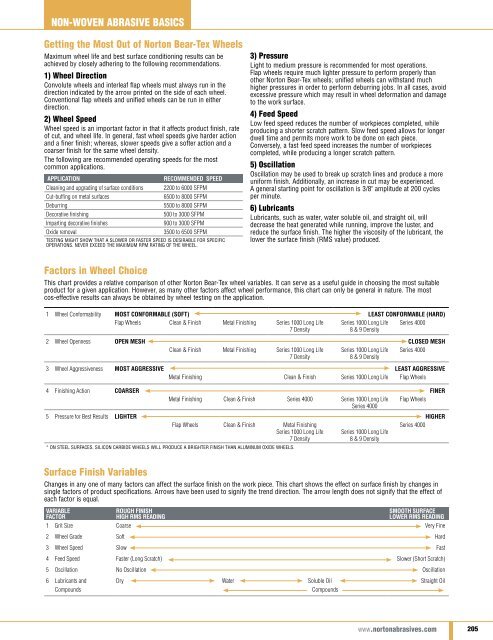Create successful ePaper yourself
Turn your PDF publications into a flip-book with our unique Google optimized e-Paper software.
Non-Woven Abrasive Basics<br />
Getting the Most Out of <strong>Norton</strong> Bear-Tex Wheels<br />
Maximum wheel life and best surface conditioning results can be<br />
achieved by closely adhering to the following recommendations.<br />
1) Wheel Direction<br />
Convolute wheels and interleaf flap wheels must always run in the<br />
direction indicated by the arrow printed on the side of each wheel.<br />
Conventional flap wheels and unified wheels can be run in either<br />
direction.<br />
2) Wheel Speed<br />
Wheel speed is an important factor in that it affects product finish, rate<br />
of cut, and wheel life. In general, fast wheel speeds give harder action<br />
and a finer finish; whereas, slower speeds give a softer action and a<br />
coarser finish for the same wheel density.<br />
The following are recommended operating speeds for the most<br />
common applications.<br />
Application<br />
Recommended Speed<br />
Cleaning and upgrading of surface conditions 2200 to 6000 SFPM<br />
Cut-buffing on metal surfaces<br />
6500 to 8000 SFPM<br />
Deburring<br />
5500 to 8000 SFPM<br />
Decorative finishing<br />
500 to 3000 SFPM<br />
Imparting decorative finishes<br />
900 to 3000 SFPM<br />
Oxide removal<br />
3500 to 6500 SFPM<br />
Testing might show that a slower or faster speed is desirable for specific<br />
operations. Never exceed the maximum RPM rating of the wheel.<br />
3) Pressure<br />
Light to medium pressure is recommended for most operations.<br />
Flap wheels require much lighter pressure to perform properly than<br />
other <strong>Norton</strong> Bear-Tex wheels; unified wheels can withstand much<br />
higher pressures in order to perform deburring jobs. In all cases, avoid<br />
excessive pressure which may result in wheel deformation and damage<br />
to the work surface.<br />
4) Feed Speed<br />
Low feed speed reduces the number of workpieces completed, while<br />
producing a shorter scratch pattern. Slow feed speed allows for longer<br />
dwell time and permits more work to be done on each piece.<br />
Conversely, a fast feed speed increases the number of workpieces<br />
completed, while producing a longer scratch pattern.<br />
5) Oscillation<br />
Oscillation may be used to break up scratch lines and produce a more<br />
uniform finish. Additionally, an increase in cut may be experienced.<br />
A general starting point for oscillation is 3/8" amplitude at 200 cycles<br />
per minute.<br />
6) Lubricants<br />
Lubricants, such as water, water soluble oil, and straight oil, will<br />
decrease the heat generated while running, improve the luster, and<br />
reduce the surface finish. The higher the viscosity of the lubricant, the<br />
lower the surface finish (RMS value) produced.<br />
Factors in Wheel Choice<br />
This chart provides a relative comparison of other <strong>Norton</strong> Bear-Tex wheel variables. It can serve as a useful guide in choosing the most suitable<br />
product for a given application. However, as many other factors affect wheel performance, this chart can only be general in nature. The most<br />
cos‐effective results can always be obtained by wheel testing on the application.<br />
1 Wheel Conformability MOST CONFORMABLE (SOFT) LEAST CONFORMABLE (HARD)<br />
Flap Wheels Clean & Finish Metal Finishing Series 1000 Long Life<br />
7 Density<br />
Series 1000 Long Life<br />
8 & 9 Density<br />
Series 4000<br />
2 Wheel Openness OPEN MESH CLOSED MESH<br />
Clean & Finish Metal Finishing Series 1000 Long Life<br />
7 Density<br />
Series 1000 Long Life<br />
8 & 9 Density<br />
Series 4000<br />
3 Wheel Aggressiveness MOST AGGRESSIVE LEAST AGGRESSIVE<br />
Metal Finishing Clean & Finish Series 1000 Long Life Flap Wheels<br />
4 Finishing Action COARSER FINER<br />
Metal Finishing Clean & Finish Series 4000 Series 1000 Long Life Flap Wheels<br />
Series 4000<br />
5 Pressure for Best Results LIGHTER HIGHER<br />
Flap Wheels Clean & Finish Metal Finishing<br />
Series 4000<br />
Series 1000 Long Life<br />
7 Density<br />
Series 1000 Long Life<br />
8 & 9 Density<br />
* On steel surfaces, silicon carbide wheels will produce a brighter finish than aluminum oxide wheels.<br />
Surface Finish Variables<br />
Changes in any one of many factors can affect the surface finish on the work piece. This chart shows the effect on surface finish by changes in<br />
single factors of product specifications. Arrows have been used to signify the trend direction. The arrow length does not signify that the effect of<br />
each factor is equal.<br />
VARIABLE<br />
FACTOR<br />
ROUGH FINISH<br />
HIGH RMS READING<br />
SMOOTH SURFACE<br />
LOWER RMS READING<br />
1 Grit Size Coarse Very Fine<br />
2 Wheel Grade Soft Hard<br />
3 Wheel Speed Slow Fast<br />
4 Feed Speed Faster (Long Scratch) Slower (Short Scratch)<br />
5 Oscillation No Oscillation Oscillation<br />
6 Lubricants and Dry Water Soluble Oil Straight Oil<br />
Compounds Compounds<br />
www.nortonabrasives.com 205

















